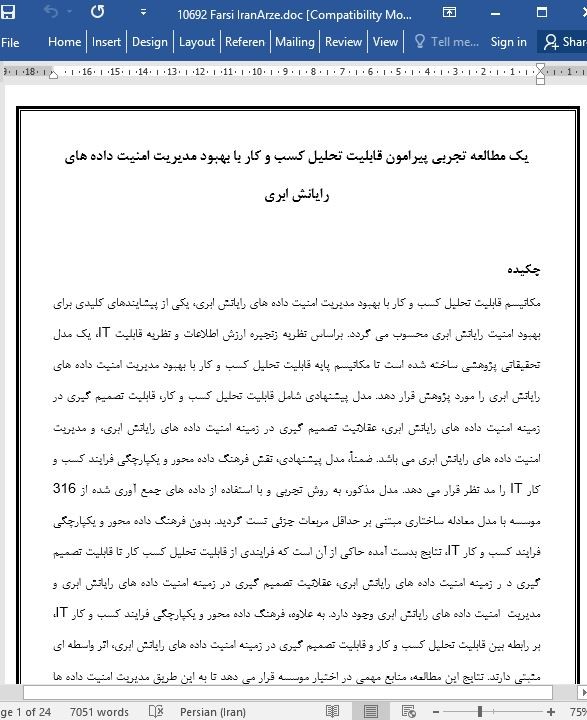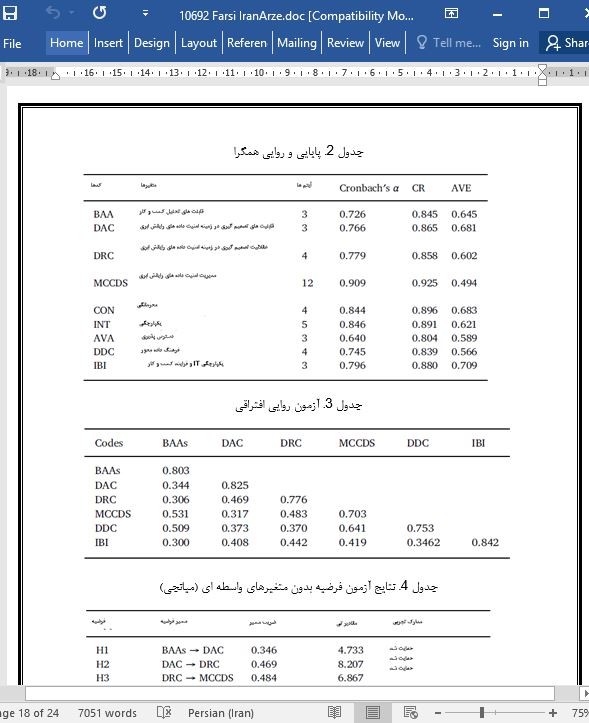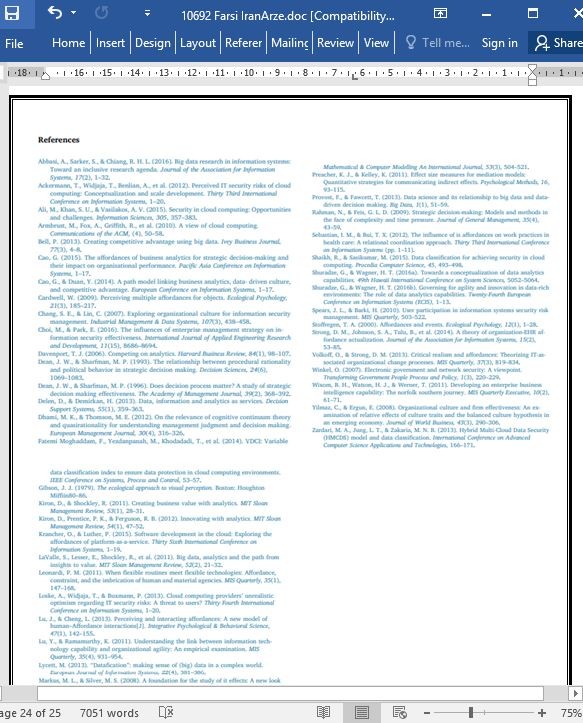
قابلیت تحلیل کسب و کار با بهبود مدیریت امنیت داده های رایانش ابری
چکیده
مکانیسم قابلیت تحلیل کسب و کار با بهبود مدیریت امنیت داده های رایانش ابری، یکی از پیشایندهای کلیدی برای بهبود امنیت رایانش ابری محسوب می گردد. براساس نظریه زنجیره ارزش اطلاعات و نظریه قابلیت IT، یک مدل تحقیقاتی پژوهشی ساخته شده است تا مکانیسم پایه قابلیت تحلیل کسب و کار با بهبود مدیریت امنیت داده های رایانش ابری را مورد پژوهش قرار دهد. مدل پیشنهادی شامل قابلیت تحلیل کسب و کار، قابلیت تصمیم گیری در زمینه امنیت داده های رایانش ابری، عقلانیت تصمیم گیری در زمینه امنیت داده های رایانش ابری، و مدیریت امنیت داده های رایانش ابری می باشد. ضمناً، مدل پیشنهادی، نقش فرهنگ داده محور و یکپارچگی فرایند کسب و کار IT را مد نظر قرار می دهد. مدل مذکور، به روش تجربی و با استفاده از داده های جمع آوری شده از 316 موسسه با مدل معادله ساختاری مبتنی بر حداقل مربعات جزئی تست گردید. بدون فرهنگ داده محور و یکپارچگی فرایند کسب و کار IT، نتایج بدست آمده حاکی از آن است که فرایندی از قابلیت تحلیل کسب کار تا قابلیت تصمیم گیری د ر زمینه امنیت داده های رایانش ابری، عقلانیت تصمیم گیری در زمینه امنیت داده های رایانش ابری و مدیریت امنیت داده های رایانش ابری وجود دارد. به علاوه، فرهنگ داده محور و یکپارچگی فرایند کسب و کار IT، بر رابطه بین قابلیت تحلیل کسب و کار و قابلیت تصمیم گیری در زمینه امنیت داده های رایانش ابری، اثر واسطه ای مثبتی دارند. نتایج این مطالعه، منابع مهمی در اختیار موسسه قرار می دهد تا به این طریق مدیریت امنیت داده ها رایانش ابری را با استفاده از تحلیل کسب و کار تقویت نماید.
1. مقدمه
سیستم های اطلاعاتی داخلی سنتی، که به سرمایه گذاریهای پیوسته ای نیاز دارند، برای موسسات کمتر جذاب می شوند، در حالیکه خدمات یا سرویس های فناوری اطلاعات طبق تقاضا، مبتنی بر رایانش ابری، شهرت زیادی کسب می کنند (Mircea، 2012). داده های حساس در مرکز داده های داخلی در سیستم اطلاعات داخلی ذخیره می شود، که از سوی موسسه محافظت می شوند. مهاجرت ابر نشان می دهد موسسه حق کنترل امنیت داده ها را از دست خواهد داد. داده ها، مبنایی برای بقای یک موسسه محسوب می شوند، و از دست دادن کنترل روی داده ها، موجب بروز ریسک های امنیتی بیشتری نسبت به سیستم های اطلاعات داخلی سنتی می شود (Ali, Khan, & Vasilakos, 2015 ).
Abstract
The mechanism of business analytics affordances enhancing the management of cloud computing data security is a key antecedent in improving cloud computing security. Based on information value chain theory and IT affordances theory, a research model is built to investigate the underlying mechanism of business analytics affordances enhancing the management of cloud computing data security. The model includes business analytics affordances, decision-making affordances of cloud computing data security, decision-making rationality of cloud computing data security, and the management of cloud computing data security. Simultaneously, the model considers the role of data-driven culture and IT business process integration. It is empirically tested using data collected from 316 enterprises by Partial Least Squares-based structural equation model. Without data-driven culture and IT business process integration, the results suggest that there is a process from business analytics affordances to decision-making affordances of cloud computing data security, decision-making rationality of cloud computing data security, and to the management of cloud computing data security. Moreover, Data-driven culture and IT business process integration have a positive mediation effect on the relationship between business analytics affordances and decision-making affordances of cloud computing data security. The conclusions in this study provide useful references for the enterprise to strengthen the management of cloud computing data security using business analytics.
1. Introduction
The traditional internal information systems, which need continuous investments, is becoming less attractive to the enterprise, while on-demand information technology services based on cloud computing are increasingly becoming popular (Mircea, 2012). The sensitive data is stored in the internal data center in the traditional internal information system, which is protected by the enterprise. Cloud migration denotes that the enterprise will lose the right to control data security. Data is the basis for the survival of an enterprise, and the loss of control over data results in greater security risks than the traditional internal information systems (Ali, Khan, & Vasilakos, 2015).
چکیده
1. مقدمه
2. مروری بر ادبیات
2.1. امنیت داده های رایانش ابری و تحلیل کسب و کار
2.2. قابلیت IT
2.3. عقلانیت (معقولیت) تصمیم گیری
3. مدلها و فرضیات تحقیق
3.1. رابطه بین BAA و DAC
3.2. رابطه بین DAC و DRC
3.3. رابطه بین DRC و MCCDS موثر
3.4. فرهنگ داده محور و نقشش
3.5. یکپارچگی فرایند کسب و کار IT و نقشش
4. روش تحقیق
4.1. طراحی پرسشنامه و ابزارهای اندازه گیری
4.2. جمع آوری داده ها
4.3. روش تحلیل داده ها
5. نتایج تحلیل داده ها
5.1. مدل اندازه گیری
5.2. واریانس روش مشترک
5.3. تحلیل مدل معادله ساختاری
6. بحث و مبانی تحقیق
6.1. مشارکت های نظری
6.2. مبانی عملی
7. نتایج و محدودیت ها
ABSTRACT
1. Introduction
2. Literature reviews
2.1. Cloud computing data security and business analytics
2.2. IT affordances
2.3. Decision-making rationality
3. Research models and hypothesis
3.1. Relationship between BAAs and DAC
3.2. Relationship between DAC and DRC
3.3. Relationship between DRC and the effective MCCDS
3.4. Data-driven culture and its role
3.5. IT business process integration and its role
4. Research method
4.1. Questionnaire design and measurement tools
4.2. Data collection
4.3. Data analysis method
5. Data analysis results
5.1. Measurement model
5.2. Common method variance
5.3. Structural equation model analysis
6. Discussions and implications
6.1. Theoretical contributions
6.2. Practical implications
7. Conclusions and limitations
- اصل مقاله انگلیسی با فرمت ورد (word) با قابلیت ویرایش
- ترجمه فارسی مقاله با فرمت ورد (word) با قابلیت ویرایش، بدون آرم سایت ای ترجمه
- ترجمه فارسی مقاله با فرمت pdf، بدون آرم سایت ای ترجمه



